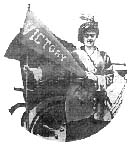 RECREATING A SUFFRAGETTE PARADE
RECREATING A SUFFRAGETTE PARADE RECREATING A SUFFRAGETTE PARADE
RECREATING A SUFFRAGETTE PARADEby Michael Orban and Patricia Everly
On May 2, 1914, a group of courageous women took to the streets of Pittsburgh in support of the era's most controversial topic-women's right to vote. At Carnegie Science Center's Miniature Railroad & Village a new exhibit commemorates this event, as well as the 75th anniversary of the 19th amendment to the U.S. Constitution.
Through newspaper articles found on microfilm at Carnegie Library of Pittsburgh, we learned much about Jeannie Bradley Roessing, Mrs. Julian Kennedy and Mary Bakewell-the innovative Pittsburgh women who led the local fight for women's suffrage and who greatly impacted women across the United States. Through a careful combination of educating women and designing methods of lobbying for the vote, they developed what became known as the "Pittsburgh Plan" for leading the state of Pennsylvania into suffrage.
According to the colorful newspaper accounts, the 1914 parade was led by the "Boss of the Road," Mrs. Julian Kennedy. She was followed by "Liberty Bell" Jeannie Bradley Roessing, in the same car that she drove to each of Pennsylvania's 67 counties lobbying for enfranchisement. Next in line was Mary E. Bakewell, color bearer, who "bore up well under the weight of the large American flag," according to the Gazette Times.
These suffragettes were followed by 10 girls in white with yellow sashes representing the 10 suffrage states, a contingent from the National Association of Colored Women and a group of "prominent men," including three city councilmen, who the Gazette Times said "scorned possible criticism on the part of their brothers and joined with their sisters." Behind them were representatives from the Pennsylvania College for Women-now Chatham College, a group of professional women, and mounted police, marching bands, Boy Scouts and a motorcade.
Our research into the parade produced an authentic parade-day flyer that had become fragile with age, apparently untouched since it was filed away in the library's Pennsylvania Department decades ago. Copies of the flyer can be handed out to Miniature Railroad visitors, just as they were to Pittsburghers along the parade route in 1914. The flyer lists common arguments against women's suffrage, juxtaposed with counterarguments by the Pennsylvania Woman Suffrage Association. For instance, "Some Say: The majority of women don't want to vote, and women will not vote when they are given the right. We Say: The number who want the vote is always many times greater than the number who don't, and official figures show women DO vote largely wherever they have the right." Or, "Some Say: Women have enough to do without voting. We Say: Voting takes only a few minutes and can be done on the way to the market." Or even, "Some Say: It would double the ignorant vote. We Say: One-third more girls than boys attend high schools, and women are rapidly becoming the more educated class."
Western Pennsylvania history has been carefully presented by the Miniature Railroad & Village since 1954. The exhibit is now open for the holiday season.
Michael Orban and Patricia Everly are coordinator and assistant coordinator, respectively, of the Miniature Railroad & Village at Carnegie Science Center.